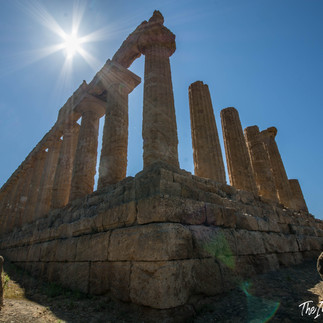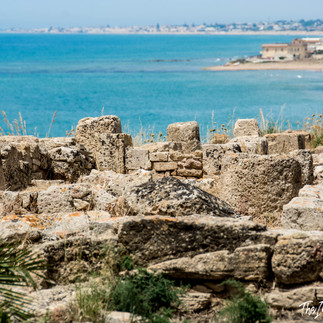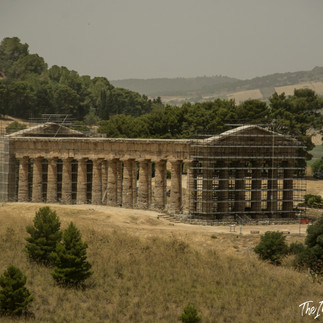Agrigento, Selinunte, Segesta (Sicily). Travel notes from the Valley of the Temples.
- The Introvert Traveler
- Dec 30, 2021
- 8 min read
Updated: Mar 17
Country: Italy
Region: Sicily
Time of visit: June 2021
Suggested duration: 2 days
My rating: 8/10
After having sufficiently immersed myself in the baroque opulence of Catania and Syracuse, it was time to move towards the west, where the vestiges of Magna Graecia awaited us: Agrigento and the Valley of the Temples, Selinunte, Segesta. Then, after the amazing lunch at the Ortigia Fish Bar, we got back in the car to head west across Sicily from Syracuse to Agrigento.
I have already anticipated that driving in Sicily is a rather challenging experience; driving in the historic center of Catania is not only the equivalent of an accelerated course in defensive driving, but also a philosophical experience that leads to reconsidering the relativity of the Social Contract, the purely conventional nature of legal norms, subjectivity and interpretability of the rules of social coexistence; but it can also be seen as a free training session of unconventional thinking. Driving from Syracuse to Agrigento is more of a survival game similar to fictions like Hunger Games or Squid Game; between Syracuse and Agrigento there is no highway, but a long state road that for most of its length does not even have a double lane and the Jersey barrier; if you do not want to spend a whole day driving to cross Sicily, you must keep a speed of at least 100 km/h; at such pace, it could happen to you to identify yourself with Han Solo flying the Falcon in an asteroid field or Dirty Harry crossing a reactive training course trying not to shoot civilian silhouettes, as you try to avoid the cars that occasionally come out of unregulated side streets, in a completely unexpected way.
The journey between Syracuse and Agrigento is a succession of enchanting countryside landscapes burned by the sun, abandoned suburbs with open-air garbage dumps, suburbs devastated by entire blocks of skeletons of unfinished concrete buildings: the synthesis, for better or for worse , of rural Sicily and it is almost obvious to read the metaphor of a land made of great naturalistic, historical and artistic beauties and capable of the worst atrocities.
The arrival in the evening in Agrigento, however, reserves an extremely suggestive view when you finally see the profile of a temple illuminated by day against the background of the dark sky at the top of the acropolis.
In this post I summarize the visit to three different archaeological sites that I visited in three different days, but which are ideally similar to each other.
The visit to the Valley of the Temples, Selinunte and Segesta can be done in two days; the valley of the Temples takes half a day to visit on foot, as does Selinunte, while Segesta is a small site that can be visited in a couple of hours. My suggestion is therefore to dedicate a day to the Valley of the Temples and the city of Agrigento and another day to Selinunte and Segesta, which are an hour away from each other by car.
The Valley of the Temples is the most famous of the three sites and is one of the "obligatory" destinations when visiting Sicily. For those born and raised in Italy it is obvious to have seen sooner or later some photographs of the "Valley of the Temples"; normally the most widespread image in school texts or in postcards, before Instagram supplanted the iconographic imagery of the citizens of the world, is this (the statue is a modern work):

The recurring image of a plain of barren land, combined with the name "Valley of the Temples", has always led me to think, stupidly, that the "Valley of the Temples" was indeed a valley. The so-called Valley of the Temples is actually, of course, an acropolis and as such is located on top of a hill overlooking the surrounding valley.

Those Greeks knew a thing or two about real estate! Of course, having a lot of land not parceled out or built up, moreover without the constraints imposed by the motorway network and the superintendence of fine arts, left them great freedom of maneuver, but undoubtedly they knew how to choose the best places! The position of the Valley of the Temples, on top of a plateau full of olive trees, dominating the surrounding valley, is truly splendid and the view from some positions is spectacular. The visit to the valley of the temples consists of a walk of about 2 km from one end to the other (and two kilometers back... which is quite a walk under the Sicilian summer sky!) along a pedestrian path in a straight line along which you can see what remains of eleven Doric-style temples; two out of eleven temples are in excellent condition and still retain the intact colonnade and the tympanum above, while the others are in a more or less evident state of ruin, mainly due to successive earthquakes over the centuries. Although the Valley of the Temples is probably the most famous archaeological area compared to Selinunte and Segesta, I personally believe that it is not the most beautiful. In my youth I did classical studies and I am not completely unfamiliar with Greek history and art, however I believe that fully appreciating the value of these archaeological areas requires specific knowledge on that matter that few have. In particular, understanding the stylistic differences between the different Doric temples is something beyond my abilities.
For those without a Cambridge PhD in archeology, I believe there are two reasons to visit the three archaeological areas; the historical aspect and the beauty of the landscape. Just as those who visit Machu Picchu do not have to be experts in pre-Columbian civilizations in order to appreciate the majesty of the places, those who visit Selinunte, Segesta and the Valley of the Temples do it basically to enjoy the spectacular scenery and on the other hand to to witness the places where the foundations of the Western civilization were laid 2,500 years ago, with its heritage of scientific research, philosophy, ethical values, art. Personally, when I am in places that have had such an important history, I always stop to think which and how many men and events have passed in those places. Well, it was in these very places, as well as in Athens, that Western civilization began; here were initially defined the ethical and legal principles that still today, after almost 3,000 years, lead our civilization; the seeds of Western art, the aesthetic canons that remained substantially unchanged at least until the end of the 19th century, were planted here. Walking in the same places where characters like Pythagoras and Archimedes laid the foundations of our civilization 2,500 years ago can make you dizzy. I believe that it is this, in addition to the beauty of the places, that attracts hundreds of visitors every day.
However, as I anticipated, for those who do not have a specific background in archeology it is difficult, in the Valley of the Temples, to see much more than ruins. On a purely architectural level, what you will find in Agrigento, as well as in Selinunte and Segesta, are Doric temples. The Doric order was one of the three orders of ancient Greek and later Roman architecture; the other two canonical orders were the Ionic and the Corinthian. The Doric is most easily recognized by the simple circular capitals at the top of columns. Originating in the western Doric region of Greece, it is the earliest and, in its essence, the simplest of the orders. The Greek Doric column was fluted or smooth-surfaced, and had no base, dropping straight into the stylobate or platform on which the temple or other building stood. The capital was a simple circular form, with some mouldings, under a square cushion that is very wide in early versions, but later more restrained. Above a plain architrave, the complexity came in the frieze. Why am I saying this? Because the doric order, to the ordinary viewer is... well... quite boring! The doric temples are basically all the same. The complexity came in the friezes... but all the friezes are lost! So what makes the Valley of the Temples, Selinunte and Segesta different? First of all the setting. In the Valley of the Temples all the ruins are set on a straight line along a pedestrian path; you just have to walk by the ruins; some of them still keep the majesty of what they must have been, some are just the bones of a very ancient monument, but well... that's it.
In Selinunte not only the archaeological area is much more complex, but some temples are also found overlooking the sea, which contributes in a considerable way to the charm of the scenery. Furthermore, in Selinunte, some ruins can be visited inside, so that you can literally touch the majesty of what remains of these gigantic buildings.
While Selinunte and the Valley of the Temples are large archaeological areas, which require at least half a day to be properly visited (in particular the duration of the visit can be extended under the summer sun which will put a strain on your resistance), Segesta is an area much smaller that can be visited in an hour, maximum two.
The temple of Segesta is probably the best preserved of the three; although this is yet another Doric temple that you will see if you visit all three areas (heck, even the Greeks got tired of Doric temples and switched to the Ionic style, why shouldn't you?), the different context, surrounded by hills , makes the temple of Segesta different from the others and in any case interesting; the peculiarity of Segesta is the spectacular theater located on top of the highest hill (to visit which the use of the shuttle is highly recommended, especially in the summer months); the image of the stone steps that slope down towards the proscenium and, below, the valley as far as the eye can see down to the sea is nothing short of majestic.
When I visited Segesta, unfortunately the temple was under maintenance and not in its best shape, as you can see in the pictures below, nevertheless, even under all that steel, the temple let us glimpse its majesty and in any case, the theater was enough to justify the visit.
Having made all these considerations, my suggestion is to visit the three areas in the order I have represented: start with the Valley of the Temples, when the feeling "what? A Doric temple, again?" will not have taken possession of you and let yourself be captivated by the charm of places so full of history; continue with the visit to Selinunte, where the sight of other temples, so similar to those of Agrigento in the architectural style could begin to give you a sense of deja vu, but it will be the variety of the area and the context to renew your interest and finish with Segesta, which is a less demanding area where the imposing theater overlooking the valley below will be the ideal conclusion for two days dedicated to Magna Graecia.
A few traveling tips
After the visit to the Valley of the Temples don't be fooled by the various tourist traps surrounding the archaeological area. A few minutes away by car is Capopesca, a small restaurant recently opened (as of June 2021); when I visited them, they had only been open for a few days and there were still a few things to fix, but the premises were very promising and, considering the inexperience of the owner, who after a life as a fisherman turned to catering, I ate excellently. From what I read, they did their homework, and now it's a great fish lunch just minutes away from the Valley of the Temples.
A trip to Agrigento cannot be said to be complete without a stop at the Stairs of the Turks an iconic white rocky cliff. The best side from which to visit the cliff is the western side, whereas on the eastern side you will find a shallow seabed dotted with algae, which is the mistake that I made...

If you visit Segesta on a hot spring or summer day there chances are that at the end of the visit you will be exhausted by the heat; a few minutes away from Segesta you will find the Pispisa farmhouse, where not only will you eat excellent Sicilian cuisine at reasonable prices, but you will find a swimming pool, overlooking the vineyards, that will definitely make your day.




















































Comments